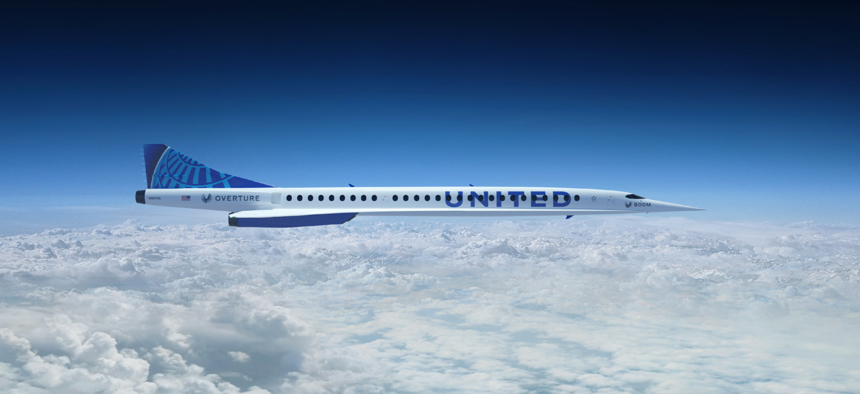
United Airlines illustration of its planned supersonic aircraft. United Airlines
Defense Business Brief: Lockheed aims to build more F-35s; Defense giants fall from Fortune 50, Supersonic jetliners, and more...
Lockheed Martin expects F-35 production to plateau around 175 aircraft in the coming years, CFO Ken Possenriede said this week. The company delivered 120 F-35s last year, 21 shy of its goal, due to COVID-19-related supply chain hiccups and factory shutdowns. The company plans to deliver between 133 and 139 F-35s this year, Possenriede said at a Wednesday Bernstein investment conference.
That’s short of the 169 planes planned for 2022.
Possenriede said Lockheed and Pentagon officials are in discussions to “hit some kind of midpoint, call it smoothing” of that production rate.
“We are in discussions with the F-35 Joint Program Office to finalize the 2022 F-35 production profile, which will consider both COVID-19 recovery and overall production smoothing to maximize production efficiency,” a Lockheed spokesman said Thursday in an emailed statement. “While initial discussions indicated 169 aircraft in 2022, we will provide a production range when finalized.”
The Pentagon asked Congress to fund 85 F-35s in 2022, under the budget proposal sent to lawmakers last week. The Pentagon did not provide a five-year spending outlook in its budget submissions since the Biden administration is doing a soup-to-nuts military strategy review.
This all suggests that Lockheed expects international orders to make up half its annual production.
Sticking with Lockheed, the company cracked the Fortune 50 this year, coming in at No. 49 with $65.398 billion in revenue. Dropping from this year’s list are Boeing and Raytheon Technologies (formerly United Technologies), whose 2020 earnings were hit hard by the pandemic and drop in commercial air travel. Boeing slid to No. 54 from 40 last year and 28 in 2019; Raytheon fell to 57 from 39 last year.
The Army, Navy, Marine Corps, Air Force, and Space Force sent Congress their unfunded priorities, totaling $17.9 billion. It’s the largest wish list total since fiscal 2018, which totaled $31.9 billion, according to figures tabulated by Capital Alpha Partners’ Byron Callan. That 2018 was sent to lawmakers in 2017 after the Trump administration’s first budget request.
The most expensive item on each list:
- Air Force: $1.4 billion for 12 F-15EX fighter jets.
- Space Force: $275 million for classified projects.
- Army: $369 million for Abrams tank upgrade for the National Guard.
- Navy: $1.7 billion for an Arleigh Burke-class destroyer.
- Marine Corps: $304 million for eight G/ATOR radars.
Supersonic transport? Military leaders have long sought ways to move troops, supplies, and weapons more quickly, a quest that has accelerated in recent years with Pentagon efforts to buy hypersonic missiles and speed up the acquisition process.
Now the military is underwriting efforts to create new supersonic jetliners, and they’re not alone. United Airlines said Thursday that it would buy 15 supersonic passenger jets (with an option for 35 more) from startup Boom Supersonic. The planes, called Overture, will be able to carry 88 passengers and fly at Mach 1.7 roughly 1,300 miles per house — almost twice the speed of sound.
By comparison, the top cruising speed of a C-17 is slightly about 500 miles per hour. Modern airliners, like the Boeing 787 Dreamliner or Airbus A350, can cruise about 150 miles per hour faster.
The U.S. Air Force has paid Boom and two other high-speed airliner startups to come up with concepts for VIP transport jets such as Air Force Two.
If supersonic transports aren’t fast enough for you, the U.S. military is looking at using rockets to resupply troops anywhere in the world within one hour. Seriously. There were a lot of eyerolls when Gen. Carlton Everhart, then the head of Air Mobility Command, suggested using rockets to resupply forward-based troops back in 2018. Well, the Air Force’s 2022 budget request includes $48 million to see if it’s doable, according to The War Zone.
Making Moves
The White House on May 28 said President Biden would nominate Kathleen Miller to be the Pentagon’s deputy comptroller. Miller is a career government servant who is currently administrative assistant to the Army secretary.
 From Defense One
From Defense One
Pentagon Shelves Plans for New Air Force Two // Marcus Weisgerber
In the meantime, the Air Force is in the early stages of developing supersonic and hypersonic passenger aircraft.
Space Force Seeks $831.7M for Unfunded Priorities // Tara Copp
Projects left out of 2022 budget would boost Cheyenne Mountain security, space-based cryptology.
US Army, UMD Form AI Partnership // Brandi Vincent
Five-year effort will launch with 18 projects focused on AI, autonomy, and modeling and simulation.
Is the Biden Administration Proud of its Pentagon Budget? // Kevin Baron
If the White House wanted to boast about its spending plans, it wouldn't have buried the news on Memorial Day weekend and given reporters just 10 minutes to ask questions.
Biden: Government Must Draft Anti-Corruption Plan by December // Jacqueline Feldscher
Analysts hailed the memo's designation of corruption as a national security threat and its deadline for action.
Afghanistan, Iraq Drawdowns Cut $3.2B From US Army Costs, Officials Say // Caitlin M. Kenney
2022 spending request would shrink service budget by a total of $3.6 billion.
US Must Strengthen Israel's Deterrence // H Steven Blum and Ari Cicurel
As Israel's adversaries look to rearm and improve their own capabilities, Washington must act to help Israel deter another fight.
NEXT STORY: Pentagon Shelves Plans for New Air Force Two




